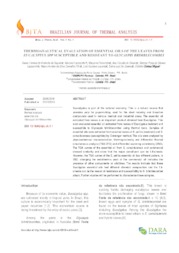Thermoanalytical evaluation of essential oils of the leaves from Eucalyptus spp susceptible and resistant to Glycaspis brimblecombei.
Thermoanalytical evaluation of essential oils of the leaves from Eucalyptus spp susceptible and resistant to Glycaspis brimblecombei.
Author(s): SIQUEIRA, G. L. de A. de; LAZZAROTTO, M.; FERNANDES, M.; SILVEIRA, A. C da; LAZZAROTTO, S. R. da S.; CARVALHO FILHO, M. A. da S.; LACERDA, L. G.; QUEIROZ, D. L. de; MIGUEL, O. G.
Summary: Euacalyptus is part of the national economy. This is a natural source that provides pulp for papermaking, coal for the steel industry and bioactive compounds used in various medical and industrial areas. The essential oil extracted from leaves is an important product obtained from Eucalyptus. This work evaluated essential oil extracted from leaves of Eucalyptus resistant and susceptible to Glycaspis brimblecombei using thermal tools. Samples of essential oils were extracted from crushed leaves of E. pellita (resistant) and E. camaldulenses (susceptible) by Clevenger method. The oils were analyzed by physicochemical characterization, thermogravimetry and differential thermal simultaneous analysis (TGA-DTA) and differential scanning calorimetry (DSC). The TGA curves of the essential oil from E. camaldulensis and commercial showed similarity and show that the major constituent can be 1,8-cineole. However, the TGA curves of the E. pellita essential oil has different pattern. In DSC, changing the endothermic peak of the commercial oil indicates the presence of other components or additives. The results indicate that these Eucalyptus essential oils had different chemical composition and the 1,8- cineole can be the reason of resistance and susceptibility to G. brimblecombei attack. Further studies will be performed to characterize these samples.
Publication year: 2016
Types of publication: Journal article
Unit: Embrapa Forestry
Observation
Some of Embrapa's publications are published as ePub files. To read them, use or download one of the following free software options to your computer or mobile device. Android: Google Play Books; IOS: iBooks; Windows and Linux: Calibre.
Access other publications
Access the Agricultural Research Database (BDPA) to consult Embrapa's full library collection and records.
Visit Embrapa Bookstore to purchase books and other publications sold by Embrapa.

